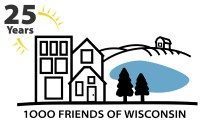On March 16th, 1000 Friends and our coalition partners submitted a letter to the Federal Highway Administration (FHWA) and Transportation Secretary Pete Buttigieg calling for a new Environmental Impact Statement (EIS) for the I-94 East-West expansion. Our efforts have started to gain national attention as the Biden Administration has shown a shifting attitude on highway expansion. Last week, we were able to meet with Stephanie Pollack, acting FHWA administrator to share our concerns.
I-94 continues to be an environmental, fiscal, and social mistake. WisDOT still does not know the traffic impacts of a post-pandemic world. Surveys show that 80% of office workers would like to work from home at least once a week and more than 50% want to work from home at least three days a week. The prudent move for Wisconsin is to repair existing roads and transit and then see how a post-pandemic workforce uses our transportation system instead of investing a billion dollars as if the pandemic never happened. A new EIS would require updated traffic counts, instead of using relying on data that is more than a decade old.
The transportation sector is the leading source of greenhouse gas emissions in the United States. Expanding I-94 would bring more cars and trucks to the road, leading to an increase in planet-warming emissions. This is incompatible with a climate-forward agenda that Governor Evers’s is promoting. A new EIS is necessary to ensure that this project’s adverse climate impacts are addressed and potential mitigation strategies are considered.
The current I-94 proposal will disproportionately harm Milwaukeeans of color. Transportation officials did not adequately evaluate, avoid, or minimize the disproportionate burden upon and harm to communities of color that would result from expanding I-94 while public transit languishes. The project would also increase pollution and health risks to the disproportionately Black and Brown Milwaukeeans who live near the highway. A new EIS could minimize this disproportionate impact and avoid the same fate as the Zoo Interchange, which is on the same corridor.
A new EIS is necessary so that the public can weigh-in on this enormous, generational investment in transportation. This EIS should consider reasonable alternatives, account for the project’s cumulative costs and benefits, and include a meaningful environmental justice analysis, an inventory of the project’s climate impacts, and a realistic assessment of the expansion’s traffic impacts.
Many people in Milwaukee consider this an expansion to be a mistake, and a proper EIS will allow their voices to be heard.
